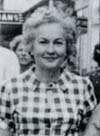Sybil Gibson
| Sybil Gibson | |
|---|---|
 | |
| Born |
Sybil Aaron February 18, 1908 Dora, Alabama, United States |
| Died |
January 2, 1995 (aged 86) Florida, United States |
| Nationality | American |
| Education | Self taught |
| Known for | Painting |
| Movement | Outsider art, Naive |
Sybil Gibson (February 18, 1908 – January 2, 1995) was an American painter. Born Sybil Aaron in Dora, Alabama, her father was a wealthy coal mine owner and farmer. She was educated at Jacksonville State Teachers College, earning a B.S. in Elementary Education, before going on to become a teacher.[1] The Estate of Sybil Gibson was represented by Woodward Gallery from 2010 to 2015.[2]
Career
For much of her adult life she had no interest in painting, having had her ambitions crushed when a college art teacher told her she had no talent.[3] However, on Thanksgiving Day 1963, aged 55, Gibson took to creating her own wrapping paper designs using tempera paint and brown paper grocery bags. This led to a fascination with creating art which lasted until her death.[4] Howell Raines wrote in June 1971 that "the paintings are not over-powering, they are truly fragile in the best sense. The colors are very delicate, and while Sybil Gibson's work is figurative, her realism is tempered with a certain dream-like quality."[5] Gibson chose to paint limited subject matter - mainly concentrating on the human form, particularly faces, as well as flowers, birds and small animals[6] Her style is considered 'folk art', and she is regarded as an outsider, or naïve artist.[1]
In May 1971, shortly before the opening of her first art exhibition, at the Miami Museum of Modern Art, Gibson disappeared, leaving drawings strewn about her yard.[7] An eccentric woman, Gibson disappeared several times.[4] Around 300 of her paintings are believed to exist in museums and private collections, although many more have been destroyed after being strewn around outside her home when she disappeared.[4]
Gibson's work has been exhibited in more than fifty one-woman exhibitions.[8] Her work is featured in the collections of the Museum of Art, Alabama; the Montgomery Museum of Fine Arts, Alabama; the Museum of American Folk Art, New York City and the New Orleans Museum of Art in Louisiana.
Personal life and death
She married Hugh Gibson in 1929, with whom she raised a daughter. Despite her prosperous upbringing, she spent much of her adult life living in poverty.[4]
In the 1940s she left Alabama and moved to Florida. She moved back to Alabama in the 1970s.
Late in life her daughter arranged for Gibson to return to Florida, where she had an operation to restore her sight. She died in 1995, aged 86.
References
- 1 2 "Sybil Gibson". Ask Art. Retrieved 2007-12-23.
- ↑ "Sybil Gibson". Woodward Gallery. Retrieved 2011-03-29.
- ↑ "Sybil Gibson - Biography". Retrieved 2007-12-23.
- 1 2 3 4 "Sybil Gibson". Marcia Weber Art Objects. Retrieved 2007-12-23.
- ↑ Howell Raines (1971-06-20). "Here she is, Miami Herald, in Birmingham". The Birmingham News. p. E1.
- ↑ "Sybil Gibson (1908–1995)". Robert Cargo Folk Art Gallery. Retrieved 2007-12-23.
- ↑ "Sybil Gibson 1908–1995". Anton Art. Retrieved 2007-12-23.
- ↑ "Sybil Gibson". Ginger Young Gallery. Archived from the original on December 17, 2007. Retrieved 2007-12-23.